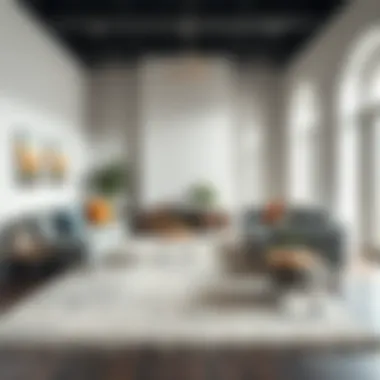Rug Shopping on Afterpay: Trends and Insights


Intro
In today’s ever-shifting world of interior decor, the way we shop for essentials like rugs is undergoing a transformation, and Afterpay is at the crux of this change. This payment method allows homeowners and decorators alike to bring their visions to life without immediate financial strain. The following sections aim to navigate this fascinating terrain, shedding light on how one can harmoniously blend finances with aesthetics.
The rug market is saturated with options, but understanding the implications of buying through Afterpay can empower consumers. It’s not merely about acquiring a rug; it’s about enhancing living spaces and making informed choices that reflect personal style. In this exploration, we will weigh benefits, discuss challenges, and highlight current trends that are reshaping the way we perceive and purchase rugs!
Furniture Design Trends
Current Trends in Furniture Design
The fluidity of modern living spaces calls for furniture that is versatile, functional, and aesthetically pleasing. A few discernible trends have begun to stand out:
- Sustainable Materials: A growing emphasis on eco-friendly products has shifted consumer preferences toward sustainably sourced or recycled materials. This is reflected in the variety of rugs available which boast organic fibers.
- Minimalism: The minimalist movement has gained traction. Clean lines and uncluttered spaces dominate, allowing a well-chosen rug to act as a focal point without overwhelming the senses.
- Vintage Revival: There’s something nostalgic about vintage designs. A ragged Persian or an aged kilim rug can add character to modern homes, making a bridge between the past and present.
These trends influence the market, encouraging retailers on Afterpay to stock a diverse range of styles that cater to varied tastes.
Influential Designers to Follow
Keeping abreast of who influences the current design landscape can be incredibly beneficial, especially for interior enthusiasts:
- Kelly Wearstler: Known for her eclectic collection, she weaves different textures and colors in unexpected ways. Her approach to rugs demonstrates how essential texture is in a room's design.
- Jonathan Adler: With a penchant for playful designs, Adler focuses on turning the mundane into the extraordinary. His rugs often embody bold colors that could enliven any space.
- Roman & Williams: This duo takes inspiration from history and architecture, creating pieces that tell a story. Their rugs and textiles reflect a deep respect for craftsmanship.
Staying informed about these designers not only inspires personal choices but also shapes broader market trends seen in retailers that accept Afterpay.
Practical Tips for Rug Selection
Choosing the Right Materials
Selecting the appropriate material is crucial for both aesthetics and durability. Here are factors to consider:
- Wool: Offers durability and resilience, making it ideal for high-traffic areas. Plus, wool rugs are often naturally stain-resistant.
- Nylon: A synthetic option that’s cost-effective and can withstand wear and tear, making it a good choice for families with children or pets.
- Cotton: Perfect for low-traffic spaces or as season-based decor, cotton rugs can add a casual vibe to your ambiance.
Maximizing Space with Smart Rug Choices
Understanding how rugs can impact the perception of space is vital in home decor. Here’s a few pointers:
- Size Matters: A larger rug can make a small room feel more spacious by unifying furnishings around it. Ensure you consider the dimensions before buying.
- Color Coordination: Think about how the rug’s colors will complement your existing palette. Neutral tones can provide a calming effect, while bold designs can invigorate the environment.
- Layering: For a dynamic look, consider layering different rugs. This can add depth and character, particularly in minimalistic spaces.
Implementing these selections enhances both the aesthetic appeal and the comfort of living spaces, engaging decor enthusiasts on a practical level.
As you step into the world of rug shopping via Afterpay, be mindful: every decision has implications not only for your wallet but for the spaces you cherish most.
Rug selections made through Afterpay can foster a genuine appreciation for the art of home design, enabling individuals to curate environments that mirror their style without overspending.
Prelude to Purchasing Rugs on Afterpay
The process of buying rugs hasn't always been so straightforward, but with the advent of modern payment methods like Afterpay, shopping for home decor has taken on a new dimension. This system allows shoppers to break down their purchases into more manageable installments, easing the financial burden that often accompanies furnishing a home. Understanding how to navigate this space can provide numerous benefits – both aesthetic and economic.
In today’s fast-paced world, many individuals prioritize style and quality for their living spaces but often find themselves constrained by budgetary limitations. The opportunity to purchase rugs through Afterpay directly addresses this challenge, enabling homeowners and decorators to acquire pieces that truly resonate with their desired decor without upfront financial stress.
While the allure of fashionable rugs is undeniable, it’s equally vital to consider how this payment solution can affect purchasing decisions. The following sections will outline what afterpay is, the increase in popularity of such payment solutions, and more, offering a comprehensive overview that can assist in making informed choices.
Defining Afterpay: A Modern Payment Method
Afterpay represents a modern twist on traditional financing, linking simplicity with accessibility. When shoppers decide to use Afterpay, they can split the cost of their rug into four equal payments, with the first payment made at the point of sale. This means that instead of shelling out a significant amount all at once, buyers can stagger their payments over the course of six weeks.


The platform has established itself as a go-to for many younger consumers who appreciate the flexibility it offers. It allows them to shop for stylish home elements while maintaining tighter control on their cash flow. As a result, they can invest in higher-quality rugs that may otherwise be outside their immediate budget.
"Afterpay’s model is all about convenience, providing an alternative to the classic credit card approach without the hidden fees often associated with financing options."
The Rise of Buy Now, Pay Later Services
The rise of Buy Now, Pay Later (BNPL) services signifies a broader movement in consumer behavior. The convenience of shopping now and paying later has transformed how people engage with retail, responding to increasing consumer demands for flexibility. With more retailers adopting Afterpay and similar models, customers have greater freedom to make purchases that enrich their spaces.
The pandemic played a crucial role in pushing this trend, as financial insecurities increased. Many shoppers turned towards flexible payment solutions to manage their spending effectively. This inclination is reflected not just in the fashion world but, importantly, in home decor, where the opportunity to acquire stunning rugs without immediate financial strain becomes increasingly appealing.
As consumers learn to navigate these options, the importance of understanding the ramifications of BNPL services becomes evident. It's not merely about getting goods; it's also about being mindful of how these purchasing practices impact overall spending patterns and financial health.
The Appeal of Rugs in Home Decor
In the realm of home decor, rugs occupy a unique space that goes beyond mere necessity. They can shape the aesthetics of a room, serve functional purposes, and even bring an emotional warmth that resonates in the air. With the increasing popularity of methods like Afterpay, acquiring these beautiful embellishments becomes more accessible than ever. This section aims to dissect the undeniable appeal of rugs, particularly in creating an inviting home environment, exploring both their tangible benefits and the delicate balance between aesthetics and practicality.
Tangible Benefits of Adding Rugs
Adding rugs to your spaces is not just a fad but a decision rooted in practicality. To start with, rugs serve the important purpose of protecting your floors from wear and tear. Whether you have hardwood, laminate, or tile, a rug acts as a buffer, absorbing impacts that threaten to scratch or scuff your flooring. Think of it as a soft landing zone that can also catch countless spills before they become an issue.
Rugs also contribute significantly to the acoustic quality of a room. If you’ve ever noticed that sound bounces around in an empty space, you know what I mean. Rugs can help to muffle noise, creating a more serene ambiance. This is especially critical in bustling family homes or apartments where multiple activities happen simultaneously.
Moreover, rugs play a considerable role in heating. They help insulate floors, making your living space feel warmer in the cooler months. Imagine stepping onto a chilly floor in the morning; a rug can make all the difference, providing warmth underfoot and making your home feel cozy.
In addition to these practical benefits, rugs can serve as effective focal points. For example, a boldly patterned Persian rug can instantly elevate a minimalistic setting, drawing the eye to its intricate details and craftsmanship. It's not just about function; it’s about how these pieces can transform ordinary spaces into extraordinary ones.
Aesthetics vs. Practicality: Finding Balance
When it comes to selecting the right rug, homeowners often find themselves caught in a tug-of-war between aesthetics and practicality. This is crucial because an eye-catching rug can brighten a room, while a practical one can withstand the realities of daily life.
Understanding your needs is the first step. If you have pets or young children, durability should take precedence. Choosing materials like wool or synthetic fibers can ensure your rug stands the test of time while still offering aesthetic appeal. On the other hand, buying a high-maintenance, delicate rug might look stunning, but it could quickly become an anchor weighing down your everyday life.
On the aesthetic side, consider the color palette and design style of your existing decor. A bright, geometric rug might clash with a home designed in rustic, earthy tones. Thus, a crucial decision awaits: do you fit the rug into your existing scheme, or do you use it as a stepping stone to introduce new colors and styles?
"A well-chosen rug can tie a room together, anchoring its design and giving space a sense of completeness."
By understanding these elements, those in the interior design space, homeowners, decorators, and stylists can make informed decisions that turn a house into a true home.
Analyzing the Market for Rugs on Afterpay
Exploring the market for rugs available through Afterpay is critical to understanding the dynamics of modern home decor shopping. As consumers seek flexibility in payment options, Afterpay caters to a growing audience who appreciate the ability to purchase items upfront while spreading the cost over time. This shift towards installment payments aligns with contemporary consumer behavior, where budgeting and financial agility are top priorities.
Leading Retailers Offering Rugs on Afterpay
A variety of retailers have recognized the potential of integrating Afterpay into their payment methods, making the process of buying rugs more convenient. Here’s a list of some of the notable ones:
- Wayfair: Offers a wide range of stylish rugs, catering to various tastes. The option to use Afterpay makes it easier to furnish spaces without a heavy upfront cost.
- Urban Outfitters: Known for trendy and eclectic designs, Urban Outfitters appeals to younger audiences looking for unique pieces. Afterpay allows for a more budget-friendly way to refresh home decor.
- Rug & Home: This retailer specializes in area rugs and provides an extensive selection. Their partnership with Afterpay means shoppers can invest in quality rugs while managing their finances effectively.
- Overstock: With its vast inventory, Overstock offers something for everyone. They also ensure that customers can acquire rugs with Afterpay, making it a smooth transaction.
"Paying in installments isn’t just about making it easier on the wallet—it’s about accessibility and opening doors for better design choices."
These retailers have tapped into a trend where consumers prioritize aesthetics yet prefer to manage their financial commitments wisely. This expansion in options not only provides access to high-quality products but also encourages responsible spending habits.
Price Range and Quality Analysis
When it comes to rugs, consumers often juggle between price and quality. The range of prices for rugs purchased via Afterpay can vary widely, typically falling into the following categories:


- Budget-Friendly Rugs: These are generally available for under $100. They serve great purposes for temporary setups, college dorms, or first apartments, but may not offer durability.
- Mid-Range Options: Prices here usually hover between $100 and $500. Mid-range rugs often balance quality and design, appealing to homeowners wanting enhanced decor without breaking the bank.
- High-End Choices: Rugs priced above $500 can be considered an investment. These often feature superior materials, craftsmanship, and unique designs, suitable for long-term integration into home decor.
Determining the connection between price and quality is essential. Lower-priced rugs might not withstand heavy foot traffic or consistent use, while higher-end options usually come with warranties that assure long-lasting performance. Therefore, consumers should consider the lifecycle of a rug when making purchases via Afterpay.
When investing in rugs through this payment method, one must reflect on the long-term value of a product. Evaluating if a cheaper rug might need replacing sooner can tip the scales toward a more expensive yet durable option. This kind of analysis ensures that spending is both sensible and aligned with personal style and home decor needs.
Understanding the Financial Implications
When it comes to purchasing rugs through Afterpay, understanding the financial implications is crucial. The allure of installments can disguise potential pitfalls, making it essential to evaluate both the costs and benefits associated with this modern payment option. As homeowners and designers look for stylish additions to their spaces, weighing these financial aspects can ensure that the purchase is not merely an impulse decision but a thoughtful one.
Assessing the Costs: Is it Worth it?
In today’s fast-paced world, convenience is king. Many people find themselves drawn to the idea of spreading payments over time rather than paying the whole sum upfront. When deciding if a rug purchased through Afterpay is worth it, consider the following points:
- Immediate Impact vs. Long-Term Cost: Buying a beautiful rug can transform a room instantly. Yet, one must assess whether the financial burden of installments outweighs the comfort and aesthetic improvement it brings. For instance, a stunning Persian rug might elevate your space but come with a steep price tag. What one must ponder is whether the monthly payments fit into the budget without straining finances.
- Interest Rates and Fees: With Afterpay, there are typically no hidden fees or interest charges if payments are made on time. However, understanding the full cost of what you’re purchasing is still vital. For example, if the system offers a zero-interest plan but includes late fees, the final price may escalate unexpectedly. Hence, it’s prudent to grasp how the repayment terms hash out in real-world scenarios.
- Budgeting Considerations: Consumers should take a hard look at their monthly expenses before diving into purchasing rugs on installments. A common advice is to maintain a budget that allows flexibility, especially when including recurring payments for products like rugs. Make a list of all monthly expenses alongside Afterpay installments to see the bigger picture.
"A purchase isn’t really a good deal if it sacrifices your overall financial stability."
Potential Drawbacks of Installment Payments
While paying in installments might seem appealing, it comes with its own set of challenges. Here’s what consumers should keep in mind regarding the drawbacks:
- Pressure to Pay: The beauty of Afterpay is in the flexibility of spreading out payments, but this can sometimes lead to a feeling of pressure. The unfortunate scenario arises when a consumer purchases several items, each requiring payments at different times. Suddenly, the commitment to multiple purchases can become overwhelming.
- Debt Accumulation: It's all too easy to overestimate one’s purchasing capacity with the convenience of quick credit options. A tempting rug might lead to additional purchases that pile up, resulting in debt rather than an enhanced living environment. Keeping a handle on spending habits becomes essential here.
- Impact on Credit: Although Afterpay generally doesn’t impact credit scores directly, irresponsible use can lead to future credit problems. For example, failing to keep up with payments could potentially lead to collections, thus affecting a buyer's creditworthiness down the line.
By understanding both the benefits and limitations of using Afterpay for rug purchases, homeowners, decorators, and interior designers can make more informed financial decisions, setting the stage for satisfying purchases that enhance their living spaces without straining their wallets.
Trends in Rug Design and Patterns
The world of interior design is always evolving, and the rugs that adorn our floors are no exception. In the context of this article, discussing the trends in rug design and patterns is essential because it highlights how these elements not only influence aesthetics but also encompass broader themes of sustainability, cultural fusion, and consumer preferences. By recognizing the latest trends, consumers can make informed choices that align with their personal style and values.
Current Design Trends in Rugs
When exploring current trends in rugs, it’s vital to note that they often reflect cultural movements and technological advancements. For instance, geometric patterns have taken the market by storm, offering a crisp and modern edge to classic designs. These patterns can make a bold statement or serve as subtle accents, allowing homeowners to play around with scale and proportion in their spaces.
Natural motifs have also seen a resurgence. Designs that feature botanical prints or organic shapes echo the growing emphasis on nature in modern decor. These pieces invite the outdoors inside, transforming our homes into serene retreats.
- Vibrant Colors: The trend is also about embracing color. Bold shades of teal, mustard yellow, and deep navy are becoming popular. These hues lend a sense of vibrancy, bringing energy to neutral palettes.
- Textured Fabrics: Rugs with varying textures are en vogue. The tactile experience adds depth and warmth to spaces, inviting people to interact more with their environment.
- Vintage Aesthetics: Vintage or distressed rugs are making their comeback. Consumers appreciate imperfections that hint at history, offering character and one-of-a-kind allure.
Understanding these trends allows homeowners and decorators to integrate contemporary styles into their existing decor effortlessly while ensuring their choices resonate with current tastes.
Materials and Sustainability in Rug Production
The materials used in rug production are increasingly under scrutiny, reflecting a heightened awareness of environmental responsibility among consumers. More brands are stepping up to the plate, opting for materials that are not only beautiful but also sustainable. Commonly sought-after materials include:
- Wool: A classic and durable fabric that is often sourced ethically. Wool rugs can be eco-friendly when they come from responsible farms.
- Jute and Sisal: These natural fibers are biodegradable and lend a rustic charm to interiors. Their coarse texture adds a tactile experience that complements softer fabrics.
- Recycled Materials: Innovation is at play here. Brands are now utilizing recycled plastics and textiles to craft stunning rugs, marrying style with sustainability.
This shift towards eco-conscious materials stems from consumer demand, making it essential for retailers to adapt and provide options that align with environmentally friendly practices. As the market evolves, expect to see more products that reflect a commitment to sustainability without compromising on quality or aesthetics.
"Today’s consumer is not just looking for beauty; they want to know the story behind their purchases and its impact on the planet."
In summary, trends in rug design and materials reflect a larger narrative about style and sustainability. As homeowners navigate the options available, a deeper understanding of these trends empowers them to enhance their spaces meaningfully, paving the way for a harmonious blend of aesthetics and ethical considerations.
Making an Informed Purchase Decision
Making an informed purchase when it comes to rugs, especially through platforms like Afterpay, is of utmost importance. This section delves into how the act of buying a rug is not merely transactional but rather a noteworthy journey that combines aesthetics, space considerations, and credible sources. For many, a rug is not just an accessory; it is a fundamental part of a living area that brings warmth and character. Thus, knowing how to approach this process can sharply affect both the visual and financial aspects of one's home decor.


The major benefit of mindfully navigating this purchase is avoiding impulse buys that can lead to regret. Many consumers might feel the thrill of getting a new rug online, but a moment’s pause and proper assessment can save time, money, and frustration. This thoughtful decision-making process enables the buyer to strike a chord between personal taste and practical needs.
In this increasingly digital world, the consumer's power is amplified. With knowledge at their fingertips, understanding one’s space, style preferences, and retailer reliability contributes tremendously to making a wise purchase. These elements together help prevent pitfalls that even the most seasoned decorator might encounter.
Evaluating Your Space: Size and Style Considerations
When you start to think about adding a rug to your space, the first thing that should come to mind is size and style. A rug must not only fit the physical dimensions of a room but also harmonize with existing decor. For instance, a sprawling area rug can anchor a seating arrangement, while a smaller accent rug might add a splash of color by a coffee table.
- Measure Before You Shop: It can’t be stressed enough that taking measurements before hunting for rugs is crucial. Think about what areas you want to cover and aim for a layout that creates balance. Where are the furniture pieces going to sit? How much room needs to be left bare?
- Style Matters: Beyond just fitting in size, it’s also about style. Traditional, contemporary, abstract, or bohemian—pick a style that reflects your taste and works with your home’s personality. For instance, a modern geometric rug might clash with a rustic themed room. A careful selection will ensure cohesiveness and comfort.
- Color Coordination: Look at the color scheme of your room. Do you want your rug to be a statement piece or blend seamlessly with your existing palette? Matching colors, or consciously contrasting them, can create a unique focal point.
Researching Retailer Reputation and Reviews
Once you've thought through how a rug can best fit into your space, the next step is to investigate the credibility of the retailers you're considering. The convenience that Afterpay offers can sometimes cloud judgment when choosing where to buy from.
- Check Reviews: Glancing through customer reviews can be revealing. Look for experiences that mention both the product quality and shipping timelines. A positive review can mean everything, especially if it addresses durability and ease of maintenance.
- Look for Return Policies: Every online shopper should be keen on understanding return policies. Comprehensive return options indicate a retailer that stands by their products. If the rug doesn’t suit your space as anticipated, knowing you have options can alleviate any post-purchase frustrations.
- Ask Questions: Don't hesitate to reach out to retailers with any inquiries. A responsive customer service can signal a company that cares about their clients’ experiences. Detail-oriented sellers are often those who prioritize quality assurance.
"One man's carpet is another man's music. Choosing the right rug is an art of balancing personal preference with practical needs."
The Impact of Payments on Consumer Behavior
The intersection of payment methods and consumer behavior is a landscape that continues to shift beneath our feet. With the advent of things like Afterpay, the dynamics of how people spend money on items such as rugs has taken on an intriguing turn. Understanding the impact of these payment systems isn’t just trivial; it defines how consumers perceive value, price, and ultimately, their own financial capabilities. As buyers gain newfound confidence in their purchasing decisions, it’s essential to explore this relationship.
Changing Attitudes Towards Spending
In years past, a buyer looking for a rug would typically think twice about parting with their money all at once. Now, with services like Afterpay, shaking hands with an item that’s caught your eye can feel less daunting. Instead of hefty upfront payments, there’s a comforting trend towards manageable installment payments. Consumers feel empowered to make purchases they might have otherwise avoided.
But it’s not just the mechanics of spending that are changing. There’s a cultural shift happening here; people are beginning to see spending as an investment rather than a loss. Consider this: when a buyer opts for a beautiful Persian rug, it’s more than just home decor—it’s a statement, an investment in comfort and style. The approach to money has transformed into a mindset where consumers actively seek out products that enhance their living spaces without the immediate financial burden.
"In the age of Afterpay, spending is no longer a silent scream but a calculated step into future savings, one rug at a time."
How Afterpay Influences Purchasing Decisions
Afterpay influences consumers at multiple levels. First and foremost, the structure of payments allows shoppers to make decisions that blend affordability with aesthetic desires. Here’s how:
- Increased Accessibility: Rugs that once seemed out of reach can now feel achievable. Buyers can explore higher-quality or trending options they might have previously bypassed due to cost.
- Impulse Buying Mitigation: Although it may seem counterintuitive, the flexibility of installment payments encourages thoughtful buying. Consumers have time to evaluate their choices without the stress of upfront expense.
- Budget Flexibility: With Afterpay, budgeting takes on a different flavor. People can plan their spending without sacrificing the beauty of their homes.
Yet, there’s a flip side. This ease can lead to overextending budgets; the thrill of retail therapy may sometimes come at the cost of overindulgence. As such, making informed decisions—backed by practical understanding of financial priorities—remains vital.
The dialogue around consumer behavior and funding methods like Afterpay is ongoing. Consumers navigating this landscape should reflect not only on how they spend but also on their overall financial health. After all, every purchase is a step in building a beautifully decorated home as well as maintaining a sustainable finances.
Culmination and Final Thoughts
The exploration of rugs available on Afterpay encapsulates not just a budding trend in consumer financing but also an emerging shift in how home decor is approached. As homeowners and decorators alike become increasingly budget-conscious, the flexibility offered by payment plans like Afterpay provides options that can truly make a difference. In the bustling tapestry of interior decoration, the interplay of practicality and aesthetics becomes crucial when it comes to selecting the perfect rugs.
Summarizing Key Insights
Through our analysis, several key insights have surfaced:
- Payment Flexibility: Afterpay allows buyers to split the cost of rugs into manageable payments, creating access to higher-quality options without the immediate financial pinch.
- Market Variety: Many reputable retailers are now embracing installment payments, which expands choices for consumers looking for specific styles or themes.
- Design & Trends: Investing in rugs can enhance a space significantly, with current trends favoring sustainability and bold patterns, delivering not just comfort but also an element of personal expression in decor.
Essentially, while budgeting remains a priority for many, the browser's choice of rugs can be elevated through financial strategy, effectively blending beauty and practicality.
Future Outlook for Rugs and Payment Methods
Looking ahead, the future of rugs and payment methods like Afterpay seems bright. As more consumers turn to installment payments, we can anticipate an even greater diversity in rug designs that cater to a modern, eco-conscious audience. Additionally, retailers may find themselves forced to enhance their inventory to include sustainable materials and innovative designs that resonate with the values of today's shoppers.
Here are some anticipated trends:
- Increased Collaborations: Expect partnerships between designers and retailers to bring exclusive collections that not only emphasize style but also affordability through payment plans.
- Tech-Driven Experiences: Technologies such as augmented reality could soon enable customers to visualize how rugs fit within their spaces before making a purchase decision.
- Educational Content: Retailers might provide educational resources on the best practices for selecting and maintaining rugs, particularly emphasizing the longevity of eco-friendly materials.
As this landscape continues to evolve, homeowners and designers will have more tools at their disposal, enhancing not just the look of a space but the ease of acquiring those essentials. This integration of decor and finance promotes a symbiotic relationship resulting in beautiful homes without the added financial strain.



